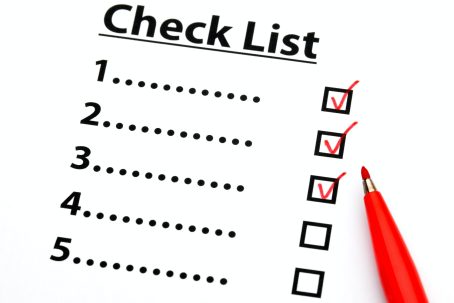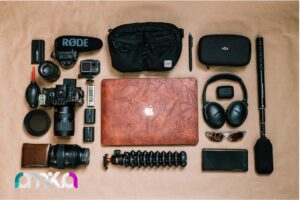New logo design checklist (2024)

Category:Graphic Design
Publish Date: 2024-02-01 12:42:09
In the highly competitive digital realm, crafting a robust online presence is imperative for businesses striving for success. A pivotal component of a brand’s identity is its logo, a visual representation that transcends mere aesthetics. A well-designed logo not only encapsulates the core essence of a business but also etches a lasting imprint on its audience. This article embarks on a journey through the nuanced world of logo design, offering a meticulous checklist to ensure that your brand’s visual identity not only survives but thrives in the bustling marketplace.
If you wish, you can also use our logo design services. For more information, visit the Custom Logo Design in Vancouver.
Before starting, here is a complete Logo Design checklist process:
Don’t panic if you are If you are confused, we have given a detailed description of each of the items in this logo design checklist below:




| Checklist Item | Description |
| I. Understanding the Brand | – Conduct stakeholder interviews to extract core brand values and mission. – Utilize SWOT analysis for internal and external insights. – Develop detailed buyer personas for target audience comprehension. – Review and align logo objectives with the brand’s mission statement. – Analyze competitor logos to identify trends and unique selling points. |
| II. Researching the Competition | – Create an inventory of competitor logos, categorizing by industry, size, and target audience. – Identify prevailing design trends through trend analysis. – Explore customer reviews and social media for audience perception. – Pinpoint areas of opportunity and potential pitfalls based on competitor analysis. |
| III. Defining Logo Objectives | – Conduct stakeholder consultations to understand diverse perspectives. – Prioritize logo objectives based on significance to the brand. – Ensure alignment with brand values and mission. – Consider target audience preferences for a more focused design approach. – Envision the role of the logo in the brand’s future for long-term objectives. |
| IV. Choosing the Right Design Style | – Analyze brand persona and values for a style that aligns seamlessly. – Consider audience preferences and industry trends for relevance. – Experiment with design mockups to visualize the resonance of different styles. – Ensure the selected style is scalable across various applications for consistent brand representation. |
| V. Color Palette Selection | – Align chosen colors with brand identity, values, and overarching message. – Explore color psychology to evoke desired emotions. – Prioritize contrast and legibility for versatile application. – Test adaptability of the color palette across diverse backgrounds for visual distinctiveness. – Ensure inclusivity and adherence to accessibility standards. |
| VI. Font Selection and Typography | – Assess brand tone for typography that reflects formality, playfulness, or seriousness. – Prioritize legibility and scalability for clear representation. – Experiment with font pairings for a harmonious combination. – Opt for unique and original fonts to enhance memorability. – Ensure consistent application across digital and print mediums. |
| VII. Scalability and Versatility | – Test logo visibility and clarity across a spectrum of sizes. – Ensure responsive design principles for digital platforms. – Evaluate adaptability in monochrome or grayscale settings. – Verify background adaptability for versatility. – Consider how the logo will appear across different media, ensuring a consistent and adaptable representation. |
| VIII. Simplicity and Memorability | – Distill the logo down to essential elements for simplicity. – Incorporate iconic imagery or symbols for memorability. – Communicate a clear and cohesive message through the logo. – Maintain consistency in design language for a unified identity. – Test with a focus group for feedback on simplicity and memorability. |
| IX. Timelessness | – Stay informed about design trends, emphasizing elements with enduring appeal. – Incorporate classic design elements for timeless aesthetics. – Opt for neutral color palettes or timeless combinations. – Steer clear of design fads for enduring value. – Seek feedback from diverse audiences for timeless appeal. |
| X. Testing and Gathering Feedback | – Assemble a diverse focus group representative of the target audience. – Use feedback for iterative design refinements. – Create digital and print mockups for varied applications. – Consider cross-cultural sensitivity for global reach. – Conduct usability testing for effective recognition and memorability. |
| XI. Intellectual Property Considerations | – Conduct comprehensive research to ensure uniqueness and avoid infringement. – Seek legal consultation for navigating intellectual property law. – Consider trademark registration for exclusive usage rights. – Maintain thorough documentation of the design process for legal evidence. – Conduct periodic intellectual property audits for ongoing protection. |

I. Understanding the Brand
Before delving into the artistic intricacies of logo creation, it is paramount to embark on a voyage of understanding the brand at its core. Practical steps to achieve this understanding include:- Conducting Stakeholder Interviews: Engage with key stakeholders, including founders, employees, and customers, to gather insights into the brand’s values and aspirations.
- SWOT Analysis: Conduct a SWOT analysis (Strengths, Weaknesses, Opportunities, Threats) to identify internal and external factors shaping the brand’s identity.
- Creating Buyer Personas: Develop detailed buyer personas to comprehend the characteristics, preferences, and behaviors of the target audience.
- Reviewing Mission Statements: Scrutinize the brand’s mission statement and vision to align the logo design with the overarching goals.
- Competitive Landscape Analysis: Examine competitors’ branding strategies, noting both successful and unsuccessful approaches to inform the logo design process.
II. Researching the Competition
In the dynamic landscape of logo design checklist, conducting a comprehensive analysis of competitors’ logos is akin to navigating a treasure trove of insights. This phase is not merely about superficial observation but entails a deep dive into the nuances that set brands apart. Practical steps for effective competition research include:- Competitor Logo Inventory: Create an inventory of competitor logos, categorizing them based on industry, size, and target audience. This provides a visual landscape to identify patterns and unique elements.
- Trend Identification: Scrutinize current design trends within the industry. Identify recurring themes, color schemes, and stylistic choices to gauge the visual language that resonates with the target audience.
- Unique Selling Points (USPs): Identify the unique elements that make competitors’ logos stand out. Analyze the features that effectively communicate their brand identity and resonate with their audience.
- Audience Perception Analysis: Explore customer reviews, surveys, and social media interactions to understand how audiences perceive competitor logos. This qualitative data provides invaluable insights into what resonates with the target market.
- Identifying Gaps and Opportunities: Pinpoint areas where competitors’ logos may fall short or miss opportunities. This analysis serves as a foundation for crafting a logo that not only meets industry standards but exceeds expectations.
III. Defining Logo Objectives in Logo Design Checklist
The process of creating a logo is not a whimsical endeavor; it’s a purposeful journey guided by clearly defined objectives. These objectives serve as the North Star, ensuring that every design element aligns seamlessly with the brand’s overarching strategy. Practical steps for setting concrete logo objectives include:- Stakeholder Consultation: Engage with key stakeholders, including founders, marketing teams, and even customers, to gather diverse perspectives on what the logo should convey.
- Objective Prioritization: Prioritize logo objectives based on their significance to the brand. Whether the primary focus is on instilling trust, conveying innovation, or highlighting specific products/services, a hierarchy ensures a cohesive and focused design.
- Alignment with Brand Values: Ensure that each defined objective aligns harmoniously with the brand’s core values and mission. The logo should serve as a visual manifestation of these principles.
- Target Audience Understanding: Consider the preferences and expectations of the target audience. A logo that resonates with the intended demographic fosters a stronger connection and lasting impression.
- Long-Term Vision: Envision the role of the logo in the brand’s future. A well-defined set of objectives should not only cater to immediate needs but also anticipate the brand’s evolution over time.

IV. Choosing the Right Design Style
Selecting the appropriate design style is akin to choosing the language through which a brand speaks visually. It’s a decision that profoundly influences how a brand is perceived. To make this crucial decision, consider the following practical steps:- Brand Persona Analysis: Conduct an analysis of the brand’s persona and values. Is the brand modern, traditional, playful, or serious? The design style should align seamlessly with these characteristics.
- Audience Preferences: Understand the preferences of the target audience. Analyze the styles that resonate with them, ensuring that the chosen design style is not only a reflection of the brand but also appeals to its core demographic.
- Competitive Benchmarking: Examine competitors’ logos to identify prevailing design styles within the industry. While originality is key, understanding industry norms ensures that the logo is both distinctive and contextually relevant.
- Scalability Consideration: Anticipate how the chosen design style will scale across various applications. A style that translates well from digital platforms to print materials ensures consistency in brand representation.
- Design Mockups: Create preliminary design mockups in different styles to visualize how each resonates with the brand. This iterative process allows for a more informed decision-making approach.
V. Color Palette Selection
Colors are the silent communicators of a brand, conveying emotions and nuances that words often fail to express. Crafting an impactful color palette involves a thoughtful blend of creativity and strategy. Practical steps for effective color palette selection include:- Brand Identity Alignment: Ensure that the chosen colors align with the brand’s identity, values, and overarching message. Consistency in color application fosters brand recognition.
- Color Psychology Exploration: Delve into color psychology to understand the emotional responses associated with different hues. Choose colors that evoke the desired emotions in the target audience.
- Contrast and Legibility: Consider the contrast between background and foreground colors, prioritizing legibility. A visually striking logo should be easily recognizable, even in monochrome or limited-color scenarios.
- Versatility Across Mediums: Test the color palette across various mediums and backgrounds to ensure its adaptability. A palette that remains vibrant and cohesive in different contexts enhances the logo’s visual impact.
- Accessibility and Inclusivity: Keep in mind accessibility standards, ensuring that the selected colors are inclusive and easily distinguishable for individuals with visual impairments.
VI. Font Selection and Typography
Typography is the voice of the written word in a logo, conveying the brand’s personality through the style of its letters. To make a meaningful selection, consider the following practical steps:- Brand Tone Assessment: Assess the brand’s tone – is it formal, casual, playful, or serious? The typography should reflect and reinforce this tone, establishing a consistent brand voice.
- Readability and Scalability: Prioritize legibility to ensure that the logo remains clear even in smaller sizes. Test the chosen font across various applications to gauge its scalability and adaptability.
- Font Pairing Exploration: Experiment with font pairings to find a harmonious combination that balances distinctiveness and coherence. A complementary pair enhances the overall aesthetic appeal.
- Uniqueness and Originality: Strive for a font that is unique to the brand, avoiding overly used or generic typefaces. Originality contributes to a logo’s memorability and distinctiveness.
- Digital and Print Consistency: Verify that the chosen font translates consistently across digital and print mediums. Consistency in typography ensures a seamless brand experience for the audience.

VII. Scalability and Versatility
The scalability and versatility of a logo are pivotal aspects that determine its adaptability across diverse platforms and applications. To ensure a logo maintains its integrity and impact, consider the following practical steps:- Size Variability Testing: Assess the logo’s visibility and clarity across a spectrum of sizes, ranging from favicon dimensions to larger formats like billboards. A scalable logo ensures legibility in all contexts.
- Responsive Design Considerations: If the logo is intended for digital platforms, ensure it adapts seamlessly to various screen sizes and resolutions. Responsive design principles are crucial for a consistent user experience.
- Monochrome and Grayscale Adaptation: Evaluate how the logo performs in monochrome or grayscale settings. A versatile design maintains its effectiveness even in situations where color reproduction is limited.
- Background Adaptability: Test the logo against different backgrounds to ensure that it remains visually distinct and does not lose its impact. Versatility in background adaptability enhances the logo’s flexibility.
- Application Across Media: Consider how the logo will appear across different media, including digital platforms, print materials, merchandise, and promotional items. A versatile logo adapts seamlessly to diverse mediums.
VIII. Simplicity and Memorability
“Simplicity is the ultimate sophistication,” said Leonardo da Vinci, and this philosophy resonates profoundly in logo design and logo design checklist. To create a logo that is both simple and memorable, designers should follow these practical steps:- Element Reduction: Strive for simplicity by distilling the logo down to its essential elements. Remove unnecessary details and complexities, focusing on conveying the core message.
- Iconic Imagery: Incorporate iconic imagery or symbols that resonate with the brand’s identity. An easily recognizable symbol enhances memorability and distinguishes the logo from competitors.
- Clear Message Communication: Ensure that the logo communicates a clear and cohesive message. A clutter-free design allows the audience to grasp the brand’s essence quickly, fostering memorability.
- Consistent Design Language: Maintain consistency in design language throughout the logo. Avoid unnecessary variations in style or complexity that could detract from the overall simplicity and memorability.
- Audience Testimonials: Test the logo with a focus group or target audience to gather feedback on its simplicity and memorability. Insights from real-world users provide valuable perspectives for refinement.
IX. Timelessness
In an era characterized by ever-evolving design trends, achieving timelessness in logo design requires a delicate balance between contemporary aesthetics and enduring appeal. To create a logo that stands the test of time, designers should follow these practical steps:- Design Trend Analysis: Stay informed about current design trends but approach them critically. Identify elements that have the potential for longevity rather than those likely to become dated quickly.
- Classic Design Elements: Incorporate classic design elements that transcend trends. Timeless logos often feature simplicity, balance, and enduring symbols that remain relevant across eras.
- Neutral Color Palettes: Opt for neutral color palettes or timeless color combinations that resist the ebb and flow of trend-driven color preferences. Neutral tones provide a timeless foundation.
- Avoiding Fads: Steer clear of design fads that may be popular momentarily but lack enduring value. A timeless logo eschews the ephemeral and embraces enduring design principles.
- Feedback from Diverse Audiences: Seek feedback from individuals of different age groups and backgrounds. A logo with timeless appeal resonates across generations and diverse audiences.

X. Testing and Gathering Feedback
The journey toward a refined and impactful logo involves more than the designer’s intuition—it requires validation from the target audience. To ensure a logo resonates effectively, designers should follow these practical steps:- Focus Group Testing: Assemble a diverse focus group representative of the target audience. Gather feedback on their initial impressions, associations, and emotional responses to the logo.
- Iterative Design Refinement: Use feedback as a guide for iterative design refinements. Adjust elements based on constructive criticism, ensuring that the logo aligns with audience expectations.
- Digital and Print Mockups: Create digital and print mockups of the logo in various applications. Assess how it appears on different mediums, considering factors such as screen resolution, printing techniques, and material textures.
- Cross-Cultural Sensitivity: If the brand has a global reach, consider cross-cultural sensitivity in the logo design. Ensure that symbols or colors do not inadvertently convey unintended meanings in different cultural contexts.
- Usability Testing: Conduct usability testing to evaluate how easily the logo is recognized and remembered. Usability is a key indicator of a logo’s effectiveness in leaving a lasting impression.
XI. Intellectual Property Considerations
Protecting the intellectual property associated with a logo is a critical step in establishing a brand’s unique identity and safeguarding against legal complications. To secure the originality of a logo design, designers should adhere to these practical steps:- Comprehensive Research: Conduct thorough research to ensure the logo design is unique and does not infringe on existing trademarks or copyrights. Utilize online databases, legal resources, and professional assistance if necessary.
- Legal Consultation: Seek legal counsel to navigate the complexities of intellectual property law. A legal professional can provide guidance on registration processes and potential legal challenges.
- Trademark Registration: Consider registering the logo as a trademark to gain exclusive rights to its use. This legal protection helps prevent unauthorized usage by competitors or third parties.
- Documentation and Records: Maintain comprehensive documentation of the design process, including drafts, iterations, and decision-making rationale. Clear records serve as evidence of originality in case of legal disputes.
- Periodic IP Audits: Conduct periodic intellectual property audits to ensure ongoing protection. As the brand evolves, so too should the measures taken to safeguard its visual identity.
Final Thoughts
Crafting a compelling and effective logo requires attention to detail, creativity, and a deep understanding of the brand’s essence. By following this comprehensive logo design checklist, businesses can create a visual identity that not only reflects their values but also leaves a lasting impression on their target audience. In the fast-paced world of digital marketing, Ramikar stands out as a beacon of innovation and excellence. Our SEO and digital marketing services are meticulously crafted to elevate your brand’s online presence, driving traffic and converting leads into loyal customers. With a team of seasoned professionals, we tailor strategies to meet the unique needs of each client, ensuring maximum visibility in the digital landscape. [elementor-template id=”19628″]FAQs
Why is logo design crucial for a brand’s success? A logo is a visual representation of a brand, creating a lasting impression and conveying its essence to the audience. How does understanding the brand impact logo design? Deep brand understanding ensures the logo aligns with values, mission, and resonates with the target audience. Why is researching competition vital in logo design? Competitor analysis identifies trends, unique selling points, and pitfalls, guiding the creation of a distinctive logo. What role does color play in logo design? Colors evoke emotions and perceptions, influencing the visual impact and alignment with brand values. Why is font selection significant in logo design? Fonts convey brand personality; legibility, scalability, and consistency across mediums are key considerations. How does scalability impact logo design? A scalable logo ensures clear representation across various sizes and adapts to different platforms consistently. Why is intellectual property consideration essential in logo design? Protecting intellectual property ensures the logo’s uniqueness, guarding against legal issues and establishing a unique brand identity.Recent Articles:

Video Marketing Canada: Best Strategies for 2025
7 months ago
5 min 25 sec read

Photography Services Canada: For Web & Social Media Use
8 months ago
5 min 2 sec read

Logo Design Canada: Create a Logo That Truly Stands Out
8 months ago
4 min 38 sec read
Let us help !
Related Posts
Comments
0
0
votes
Article Rating
Subscribe
Login
0 Comments
Oldest
Newest
Most Voted
Inline Feedbacks
View all comments






